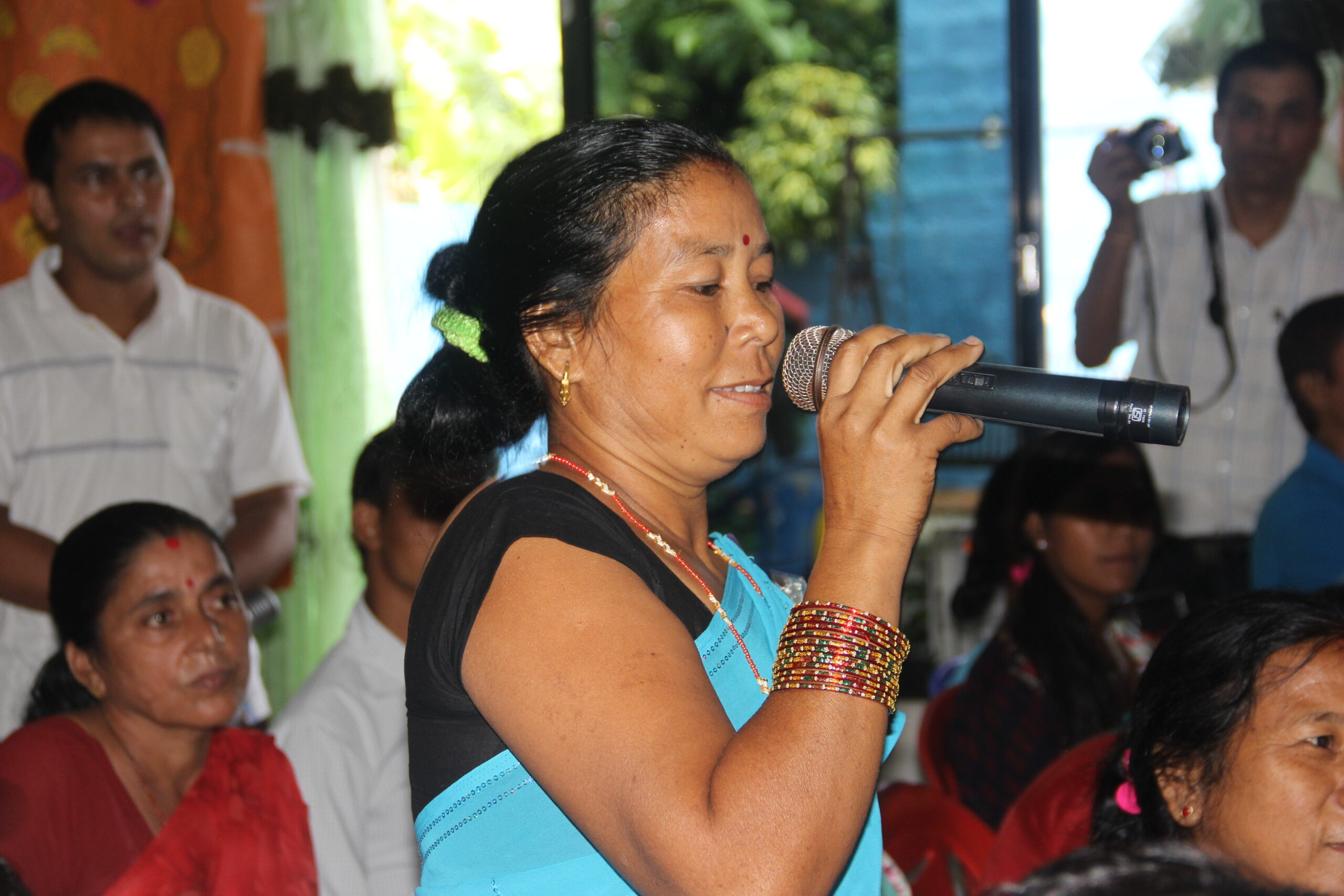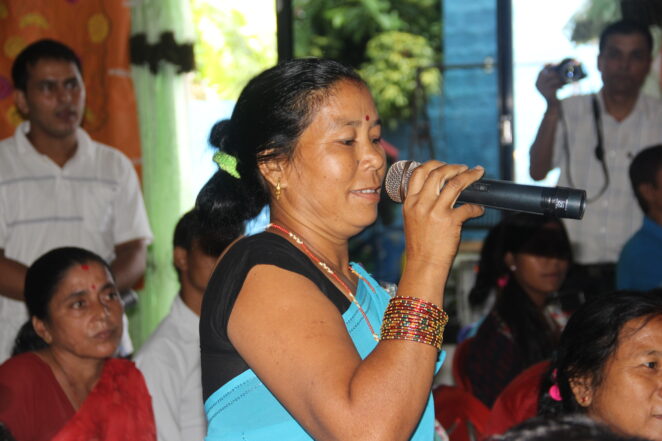Case-study /
From slave to community leader in Nepal


Indra kumari sharing her experience during a large public event, Bardiya, Nepal. (Credit: © Hariyo Ban project staff / CARE)
From slave to community leader in Nepal
“My name is Indra Kumari Tharu. I was born into a family of Kamaiyas (bonded labourers/slaves) in Ramnagar, Bardiya district of Nepal, 40 years ago. We became free from our landlords with the declaration of abolishment of the Kamaiya Pratha (bonded labour/slavery system) on 17 July 2000, by the government of Nepal. However, we were yet to be free from poverty, illiteracy, unemployment and archaic customs of an oppressive patriarchal society.
“Initially, I was quite lucky compared to most of my neighbours, as I soon found employment with the Family Planning Association – first as a community mobiliser and then as a female health volunteer. I was also elected as a member of the executive committee of the Women’s Community Forest User Group (CFUG) in Daulatpur and, a year later, was elected their chairperson. However, I was forced to quit these positions after a while, since I felt extremely demoralised. I would often receive derogatory and defamatory remarks and harassment from people, especially when I was trying to raise awareness about family planning and reproductive, maternal and child health. In a strict patriarchal society like ours, it’s considered very shameful for women to go outside the domestic sphere, earn a living or speak with strangers in public. Since my job required all of these activities, as well as talking about sex and reproduction, a taboo subject, I was ostracised from my community.
“For a number of years I was then confined to the role of a homemaker, but when I was offered the opportunity to participate in the development of a Community Learning Action Center (CLAC) in 2012,I once again mustered the courage to step outside my domestic sphere to seek a better future for my family and community.”
Capacity development for local civil society and government institutions
“I received leadership and governance training from CARE, following which I was able to reactivate the board of our women’s forestry group. Our aim is to conserve the forest area and allocate its resources for the benefit of the most vulnerable members of our community. Through CLAC, I have also been involved in different local development activities. For example, one day at CLAC we were discussing the need for proper toilets in order to improve sanitation and hygiene, and reduce the prevalence of diseases (a problem that can be made worse by the impacts of climate change), avoid snakebites and improve women’s security and privacy. To set an example, I first built a toilet at my home, then, together with my colleagues from CLAC, we conducted a door-to-door awareness campaign on the need for better sanitation and toilets. Today, each household in our village has a toilet of some sort – some are temporary pit latrines for use until families can afford to construct a more permanent facility.”
Disaster risk reduction strategies to reduce the impact of hazards on vulnerable households
“Our village suffers from floods and erosion from the Karnali River, threatening our lives and destroying our fields and homes. The flooding has become more and more severe in recent years and I learned in CLAC that this could be due to the adverse impacts of climate change. To minimise this hazard and adapt to the changing climate, we have now developed a Community Adaptation Plan of Action (CAPA) with the support of the CARE project team. As part of implementation of the CAPA, we have already installed embankments and level-checking dams along the banks of the river, and have planted bamboo and different tree saplings, to try and improve the soil structure and drainage.”
Advocacy and social mobilisation to address the underlying causes of vulnerability
“I received some land from the government after we CLAC women participants took the initiative and visited different government agencies and non-profit organisations to finally make the government keep its promise of providing land certificates to freed Kamaiyas families in our community. We are now working on leveraging other resources from different government agencies and other non-government organisations to implement other adaptation activities listed and planned under the CAPA, with the support and guidance of the CARE project. Through this experience, we have gained the confidence and knowledge to approach government and development agencies and begin to implement projects on our own.”
Promotion of climate-resilient livelihoods strategies
“I am now rearing two pigs, twenty chickens and four goats, as well as growing crops and vegetables on my land. I am able to meet my household’s daily expenses as well as send my two daughters and my son to English language boarding schools with the earnings I make from my livelihood activities. Following my example, many other families in my village have also sent their children, including girls, to school and more women are participating in income-generation activities. Myself and other women have also started to gain a higher status and more respectful treatment from our community, which gives me hope for the future, and of seeing a more equitable society for marginalised groups and women.
“With these positive developments in our community, people, even those who used to call me derogatory names, now acknowledge me as a leader and seek my advice. This has made me very happy and encouraged me to seek more positive transformations, not just in my village, but also in other marginalised communities in Nepal. I have been participating in different local and national platforms to share my experiences, which has boosted my confidence and together with the women’s group, formed through the CLAC; I believe we can really make a difference.”
